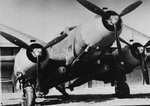SM.84
| Country | Italy |
| Manufacturer | Savoia-Marchetti |
| Primary Role | Torpedo Bomber |
| Maiden Flight | 5 June 1940 |
Contributor: C. Peter Chen
ww2dbaseIn 1939, the design process began for the SM.84 bombers which was planned to be the replacement for the SM.79 design, particularly an attempt to add greater torpedo bombing capability to the Italian forces. The prototype that took flight in the following year shared the same wings as its predecessor, but the steel tubing and fabric/plywood/duraluminum covering fuselage was modified. The aircraft immediately suffered problems, however. The engines were unreliable, and pilots reported difficulties at takeoff and landing due to the weight of the aircraft. Nevertheless, the Italian air force, the Regia Aeronautica, submitted a request for 246 aircraft; the number was later increased to 309. In active service, they were first used as torpedo bombers starting in Feb 1941; in this role, SM.84 bombers based in Sardinia, Italy damaged HMS Nelson in the Mediterranean Sea, sending the British battleship to repair yards for the subsequent six months. In Aug 1942, they were deployed the counter the British convoy mission code named Operation Pedestal, but they achieved little to the stop the convoy. SM.84 bombers acted as medium bombers starting in Jul 1941 when they were launched from Sicily, Italy to bomb Malta. Nevertheless, because not all issues were addressed satisfactorily, they never replaced the SM.79 bombers as originally intended, and the older S.79 and Z.1007 aircraft remained the favored torpedo bombers of the Italians. After the Italian surrender, most of the about 100 remaining serviceable units were captured by the Germans, who deployed them as transports until the end of the war. The Italian co-belligerent air force operated 7 of them and also used them as transports.
ww2dbaseSource: Wikipedia.
Last Major Revision: Oct 2007
SPECIFICATIONS
SM.84
| Machinery | Three Piaggio P.XI RC40 radial engines rated at 1,000hp each |
| Armament | 1x12.7mm dorsal machine gun, 1x12.7mm ventral Scotti machine gun, 2x12.7mm side Scotti machine guns, up to 1,000kg internal bombs, up to 1,600kg of external ordnance |
| Crew | 5 |
| Span | 21.10 m |
| Length | 17.93 m |
| Height | 5.42 m |
| Wing Area | 60.80 m² |
| Weight, Empty | 8,550 kg |
| Weight, Maximum | 12,750 kg |
| Speed, Maximum | 431 km/h |
| Service Ceiling | 8,200 m |
| Range, Normal | 1,830 km |
Photographs
 |
Você gostou deste artigo ou achou este artigo útil? Se sim, considere nos apoiar no Patreon. Qualquer valor já vai ajudar! Obrigado. Por favor, ajude-nos a divulgar o site: Fique atualizado com WW2DB: |

- » The Emperor of Japan Planned to Honor WW2-era Japanese POWs in Mongolia (4 Jul 2025)
- » US State Lawmaker John Winter Caught Using Racial Slur "Jap" and Apologized (11 Jun 2025)
- » Köln/Cologne Evacuated After Discovery of WW2 Bombs (4 Jun 2025)
- » Race, Holocaust, and African-American WW2 Histories Removed from the US Naval Academy Library (7 Apr 2025)
- » US Government Plans to Purge WW2 Information (17 Mar 2025)
- » Ver todas as notícias
- » 1,179 biografias
- » 337 eventos
- » 45,089 entradas na linha do tempo
- » 1,245 navios
- » 350 modelos de aeronaves
- » 207 modelos de veículos
- » 376 modelos de armas
- » 123 documentos históricos
- » 261 instalações
- » 470 eventos
- » 28,488 fotos
- » 365 mapas
General Douglas MacArthur at Leyte, 17 Oct 1944
Por favor, considere nos apoiar no Patreon. Mesmo R$1 por mês já faz uma grande diferença. Obrigado!
Ou, por favor, nos apoie adquirindo alguns produtos do WW2DB na TeeSpring. Obrigado!